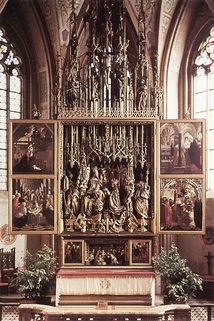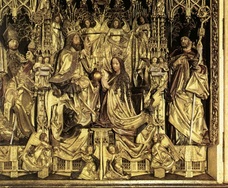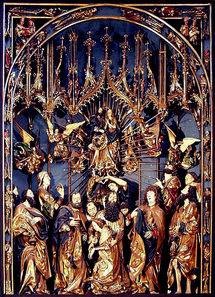Fifteenth and Sixteenth Century Woodcut Sculptors
Among religious art of the fifteenth and sixteenth century, wooden sculpture is one of the most precious. Tilman Riemenschneider is just one of those sculptors to create such beautiful masterpieces. Looking at altarpieces done by both Riemenschneider and some of Riemenschneider’s peers of the time, Michael Pacher, and Veit Stoss, we can easily see why wood sculptures became such prized relics. Michael Pacher, Tilman Riemenschneider, and Veit Stoss pushed the boundaries of woodcut altarpieces. What one sculptor did well, the next took it a step farther, expanding our expectations through time.
Michael Pacher, who worked from 1469 to 1496, set the stage for woodcut altarpieces in 1471 with his Saint Wolfgang Altarpiece.(1) This polyptych altarpieces was a result of a contract with Benedict Eck, Abbot of Mondsee.(2) The Coronation of the Virgin, sculpted of pine and painted with gold and a variety of other colors, fills the center panel. It is surrounded by paintings from the life of Christ, and some paintings honoring the life of Mary. When the altarpiece is closed the outer panels display paintings reflecting the life of Saint Wolfgang. The predella and superstructure of the Saint Wolfgang Altarpiece, unlike the pine center corpus is intricately sculpted from limewood.(3)
The gilding of gold on the figures and decorative frame of pinnacles presents a space that brings awe to the eyes of any viewer. In combination with the gilded figures and pinnacles, the deep woodcuts Pacher employed create a play of light and dark. In certain times and lighting situations of the day, the spaces seem to never be that of one surface. An entire workshop working under Pacher’s vision, helped to create the Saint Wolfgang Altarpiece. It is believed that Pacher himself though did most of the interior paintings, but much of the superstructure wood carving was done by his workshop under his design plans.(4)
Pacher’s work is in the “florid style,” consisting of the curvature of his figures, and the lavish, intricate, vines of pinnacles that created the frame for his altarpiece.(5) Tilman Riemenschneider followed Pacher’s footsteps by also working in the “florid style,” from 1485 to the mid-1520’s.(6) However in comparing Riemenschneider’s Altarpiece of the Holy Blood and Pacher’s Saint Wolfgang Altarpiece, there is an immediate difference. Riemenschneider’s is a monochromatic work utilizing the beauty of the wood with just a brown glaze as opposed to Pacher’s with polychrome paint. This reflects a shift in public preference from painted wood sculpture to monochromatic sculpture. This also points to an appreciation of the natural material’s beauty on the part of both the artist and the patrons of Riemenschneider’s time.(7)
Located in the Church of St. Jacob, the narrative of the Holy Blood starts in the left panel with Christ’s Entry, a depiction of Christ entering Jerusalem on a donkey, the center panel consists of the Last Supper at the moment where Christ announces that one of his apostles will betray him, and in the right-hand panel is the Agony in the Garden, where Christ has been betrayed by Judas and prays alone among his sleeping apostles.(8) This monochromatic limewood altarpiece shows exactly what Riemenschneider was capable of. Without the use of color, Riemenschneider used deeper and more detailed woodcuts to convey emotion in his figures than Pacher did. Where Pacher relied on paint to convey detail some smaller details, Riemenschneider carved details into the wood to create these differentiations, and a more finished surface to his figures.(9)
Expanding on Pacher and Riemenschneider’s “florid style,” Veit Stoss, another master of wooden sculpture, demonstrated a new way of working. Stoss’s sculptures were slightly more detailed than Pacher and Riemenschneider’s works. Categorized as a Late Gothic sculptor, Stoss working from 1477 to approximately 1503, created a sense of emotion and compassion, a form of sweet and gentle gesture, which puts him among the masters. Looking at Stoss’s work Death of the Virgin, from the Altarpiece of Veit you can see the painstaking detail of his figures down to the “bulging veins” in their hands and legs.(10) Death of the Virgin is the scene of the assumption of Mary with his figures in the round. The outer panels of this polyptych are in deep relief, and create a space to depict the life of the Virgin and the Passion of the Christ.
It is evident in this piece that, “he combined two sculptural modes: the relatively straightforward, subtly continuous modeling of the human face and figure and a wild abstraction convolution and hollowing of draperies, a sense of the pure plane jutting and receding in space that surrounds his bodies with an ecstatic corona of motion.”(11) Pacher and Riemenschneider had very detailed draperies, but Stoss pushed it to another level that creates a greater sense of detail, and more variation of the surfaces, giving it even more depth than his peers.
Death of the Virgin is a polychromic sculpture. Constructed from 1477 to 1489, it predated, Riemenschneider’s Altarpiece of the Holy Blood, which was constructed from 1499 to 1505. Even though public preference or artist appreciation for the natural beauty of wood accompanied Riemenschneider’s work, the trend of monochromatic sculptures did not stick. In fact it was Stoss that painted Altarpiece of the Magdalen ten years after Riemenschneider’s completion of the work. This could reflect a shift back of preference for polychromatic sculpture.(12)
From 1469 to the mid 1520’s, Pacher, Riemenschneider, and Stoss created some of the most pivotal sculptures of the Northern Renaissance. The beauty of their works is unspeakable, and the talent they all possessed was almost other worldly. It is no doubt all of them influenced sculptors to come in the Late Gothic Baroque, and many more after that. Thankfully due to restoration, and maintenance, some of their works are still intact, and in the case of Pacher’s Saint Wolfgang Altarpiece, and Riemenschneider’s Altarpiece of the Holy Blood even in situ.
Michael Pacher, who worked from 1469 to 1496, set the stage for woodcut altarpieces in 1471 with his Saint Wolfgang Altarpiece.(1) This polyptych altarpieces was a result of a contract with Benedict Eck, Abbot of Mondsee.(2) The Coronation of the Virgin, sculpted of pine and painted with gold and a variety of other colors, fills the center panel. It is surrounded by paintings from the life of Christ, and some paintings honoring the life of Mary. When the altarpiece is closed the outer panels display paintings reflecting the life of Saint Wolfgang. The predella and superstructure of the Saint Wolfgang Altarpiece, unlike the pine center corpus is intricately sculpted from limewood.(3)
The gilding of gold on the figures and decorative frame of pinnacles presents a space that brings awe to the eyes of any viewer. In combination with the gilded figures and pinnacles, the deep woodcuts Pacher employed create a play of light and dark. In certain times and lighting situations of the day, the spaces seem to never be that of one surface. An entire workshop working under Pacher’s vision, helped to create the Saint Wolfgang Altarpiece. It is believed that Pacher himself though did most of the interior paintings, but much of the superstructure wood carving was done by his workshop under his design plans.(4)
Pacher’s work is in the “florid style,” consisting of the curvature of his figures, and the lavish, intricate, vines of pinnacles that created the frame for his altarpiece.(5) Tilman Riemenschneider followed Pacher’s footsteps by also working in the “florid style,” from 1485 to the mid-1520’s.(6) However in comparing Riemenschneider’s Altarpiece of the Holy Blood and Pacher’s Saint Wolfgang Altarpiece, there is an immediate difference. Riemenschneider’s is a monochromatic work utilizing the beauty of the wood with just a brown glaze as opposed to Pacher’s with polychrome paint. This reflects a shift in public preference from painted wood sculpture to monochromatic sculpture. This also points to an appreciation of the natural material’s beauty on the part of both the artist and the patrons of Riemenschneider’s time.(7)
Located in the Church of St. Jacob, the narrative of the Holy Blood starts in the left panel with Christ’s Entry, a depiction of Christ entering Jerusalem on a donkey, the center panel consists of the Last Supper at the moment where Christ announces that one of his apostles will betray him, and in the right-hand panel is the Agony in the Garden, where Christ has been betrayed by Judas and prays alone among his sleeping apostles.(8) This monochromatic limewood altarpiece shows exactly what Riemenschneider was capable of. Without the use of color, Riemenschneider used deeper and more detailed woodcuts to convey emotion in his figures than Pacher did. Where Pacher relied on paint to convey detail some smaller details, Riemenschneider carved details into the wood to create these differentiations, and a more finished surface to his figures.(9)
Expanding on Pacher and Riemenschneider’s “florid style,” Veit Stoss, another master of wooden sculpture, demonstrated a new way of working. Stoss’s sculptures were slightly more detailed than Pacher and Riemenschneider’s works. Categorized as a Late Gothic sculptor, Stoss working from 1477 to approximately 1503, created a sense of emotion and compassion, a form of sweet and gentle gesture, which puts him among the masters. Looking at Stoss’s work Death of the Virgin, from the Altarpiece of Veit you can see the painstaking detail of his figures down to the “bulging veins” in their hands and legs.(10) Death of the Virgin is the scene of the assumption of Mary with his figures in the round. The outer panels of this polyptych are in deep relief, and create a space to depict the life of the Virgin and the Passion of the Christ.
It is evident in this piece that, “he combined two sculptural modes: the relatively straightforward, subtly continuous modeling of the human face and figure and a wild abstraction convolution and hollowing of draperies, a sense of the pure plane jutting and receding in space that surrounds his bodies with an ecstatic corona of motion.”(11) Pacher and Riemenschneider had very detailed draperies, but Stoss pushed it to another level that creates a greater sense of detail, and more variation of the surfaces, giving it even more depth than his peers.
Death of the Virgin is a polychromic sculpture. Constructed from 1477 to 1489, it predated, Riemenschneider’s Altarpiece of the Holy Blood, which was constructed from 1499 to 1505. Even though public preference or artist appreciation for the natural beauty of wood accompanied Riemenschneider’s work, the trend of monochromatic sculptures did not stick. In fact it was Stoss that painted Altarpiece of the Magdalen ten years after Riemenschneider’s completion of the work. This could reflect a shift back of preference for polychromatic sculpture.(12)
From 1469 to the mid 1520’s, Pacher, Riemenschneider, and Stoss created some of the most pivotal sculptures of the Northern Renaissance. The beauty of their works is unspeakable, and the talent they all possessed was almost other worldly. It is no doubt all of them influenced sculptors to come in the Late Gothic Baroque, and many more after that. Thankfully due to restoration, and maintenance, some of their works are still intact, and in the case of Pacher’s Saint Wolfgang Altarpiece, and Riemenschneider’s Altarpiece of the Holy Blood even in situ.
Michael Pacher, Saint Wolfgang Altarpiece, 1471-81. Limewood and pine, 12 ft 9.5 in. x 10 ft 4 in. (Center panel) Church of Saint Wolfgang, Austria.
Tilman Riemenschneider, Altarpiece of the Holy Blood, 1499-1505. Limewood, 29 ft 6.375 in. Church of Saint Jacob, Rothenburg.
Veit Stoss, Death of the Virgin, 1477-1489. Wood, 23 ft 9 in. Church of Saint Mary Cracow.
1. Stechow, Wolfgang, Northern Renaissance Art (New Jersey: Prentice-Hall, 1966), 83.
2. Chipps Smith, Jeffrey, The Northern Renaissance ( London: Phaidon, 2004), 180.
3. Ibid, 181
4. Rasmo, Nicolo, Michael Pacher ( London: Phaidon, 1971).
5. Snyder, James, Northern Renaissance Art ( New Jersey: Pearson, 2005), 277.
6. Ibid, 285
7. Ibid, 282
8. Stechow, 83.
9. Chipps, 185
10. Chipps, 185
11. Hughes, Robert. “Out of Gothic, into the Future,” Time (May 1986).
12. Snyder, 282
Page created by Amanda Thelen, Northern Renaissance Art, May 2011




